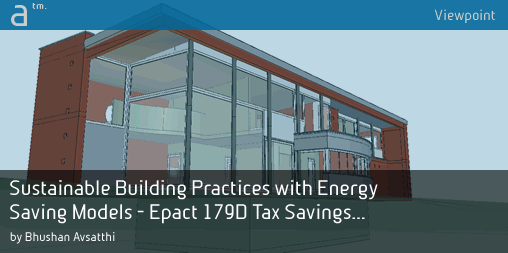Prior to electricity architects and builders made the best use of daylight by allowing penetration through windows and roofs in order to get better visibility in rooms during daytime. Then the light bulbs were invented and architects and developers started making buildings with no daylight exposure, buildings that depended completely on artificial lighting.
Advertisement
Today, the wave of green building design has swept the industry, mainly due to energy costs and problems like Greenhouse gasses, depleting energy resources and higher carbon emissions, hence erosion of the ozone layer.

Energy Saving modeling for lighting performance optimization and reduction of energy costs is done by experts (image: courtesy Bhushan Avsatthi. All rights reserved).
Within the AEC industry architects, engineers and energy consultant experts can address the societal needs to reduce carbon footprints and conserve energy resources by embracing sustainable design into their professional practices. To encourage building owners and operators to do more to conserve energy governments around the world, including the United States, offer numerous types of incentives, including tax breaks.
Energy Efficient Lighting
Today lighting systems and devices have become highly efficient and smart. As compared to traditional incandescent lights, energy efficient options such as halogen incandescent, compact fluorescent lamps and LED lights not only use around 25% to 80% less energy but also can last 3 to 25 times longer, as a result help owners save money.
Daylight Harvesting
Enabling maximum utilization of daylight within a building is called daylight harvesting. Smart daylight harvesting refers to utilization of sensors that are light sensitive. These sensors can detect the incoming light or the receding light and balance artificial lighting accordingly.
Besides daylight harvesting is also coupled with cooling and heating systems to only allow light and not let the sunlight affect the heating and cooling within the building.
Lighting control
As mentioned before smart devices detect and dim or brighten light intensity of artificial lights as and when needed. Increased use of ambient lights, shutting down lighting during non-working hours or when not in use etc., can also vastly contribute to saving energy consumption and reducing energy wastage.
Epact 179D Tax Savings for Daylight Harvesting
As per the EPAct 179D, tax savings for buildings that achieve energy cost reductions more than the range specified by ASHRE energy standards, get a minimum tax deduction of 1.80USD per square foot. As an example, a 4,000 square foot home would yield (4,000 x 1.80 = 7,200.USD). This is mainly measured on the performance of three factors: (a) lighting (b) HVAC efficiency and (c) building envelope. As per Epact 179D Tax Savings for Daylight harvesting, the reduction of energy consumption due to day lighting systems directly result in tax reductions. However, as per the act, an energy modeling approach is necessary, as it helps create effective documentation of compliance.
About Author
Bhushan Avsatthi is a senior manager, consultant, BIM expert and a green building advisor with more than 15 years of industry experience. Bhushan imbibes the prophecy of efficient and prudent use of energy in his day to day life and advices his team to do so as well. He is also involved in green initiatives like nonprofit tree plantation project and promotes using cycles for commuting small distances. Bhushan, handles a team of architects, Structural and MEP engineers, LEED consultants and Energy modeling experts.







Reader Comments
Architosh is again pleased to share another informative Viewpoint article from BIM consultant and expert Bhushan Avs…https://t.co/QhTWcUKrxn
Sustainable Building Practices with Energy Saving Models – Epact 179D Tax Savings | Architosh http://t.co/NbsDG4SapR via @sharethis
Architosh is again pleased to share another informative Viewpoint article from BIM consultant and expert Bhushan Avs…https://t.co/QhTWcUKrxn
Architosh is again pleased to share another informative Viewpoint article from BIM consultant and expert Bhushan Avs…https://t.co/QhTWcUKrxn
Sustainable Building Practices with Energy Saving Models – Epact 179D Tax Savings | Architosh http://t.co/NbsDG4SapR via @sharethis
#CAD Sustainable Building Practices with Energy Saving Models – Epact 179D Tax Savings for Daylight Harvesting http://t.co/H70cuABs5z
#CAD Sustainable Building Practices with Energy Saving Models – Epact 179D Tax Savings for Daylight Harvesting http://t.co/H70cuABs5z
Matthew Ivanov liked this on Facebook.
Matthew Ivanov liked this on Facebook.
Sustainable Building Practices with Energy Saving Models – Epact 179D Tax Savings for Daylight Harvesting http://t.co/YUAVN5YoTp
Sustainable Building Practices with Energy Saving Models – Epact 179D Tax Savings for Daylight Harvesting http://t.co/YUAVN5YoTp
Sustainable Building Practices with Energy Saving Models… http://t.co/IJZNNUDovD
Sustainable Building Practices with Energy Saving Models… http://t.co/IJZNNUDovD
RT @11×17: #CAD Sustainable Building Practices with Energy Saving Models – Epact 179D Tax Savings for Daylight Harvesting http://t.co/H70cu…
RT @11×17: #CAD Sustainable Building Practices with Energy Saving Models – Epact 179D Tax Savings for Daylight Harvesting http://t.co/H70cu…
RT @11×17: #CAD Sustainable Building Practices with Energy Saving Models – Epact 179D Tax Savings for Daylight Harvesting http://t.co/H70cu…
Comments are closed.